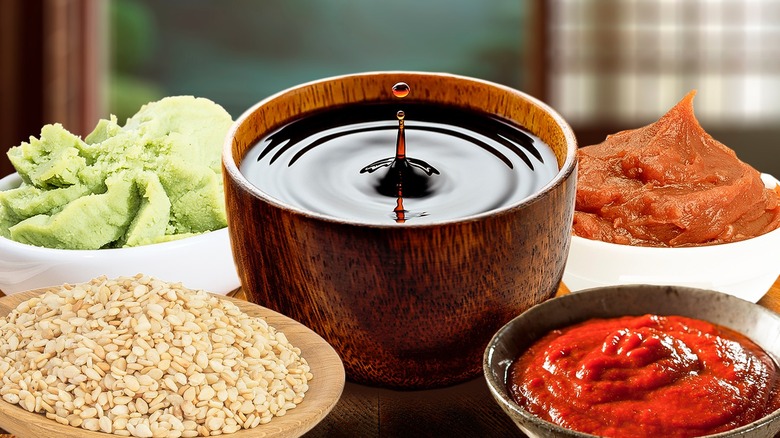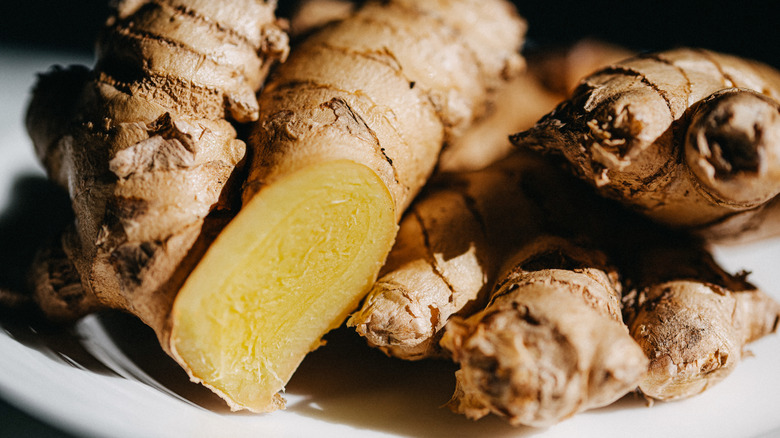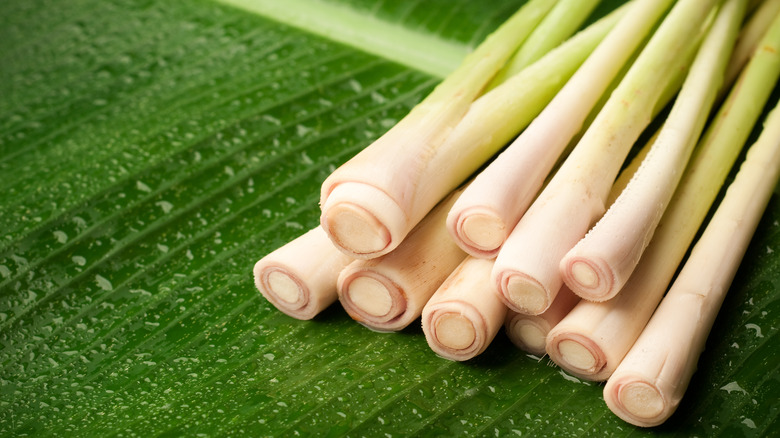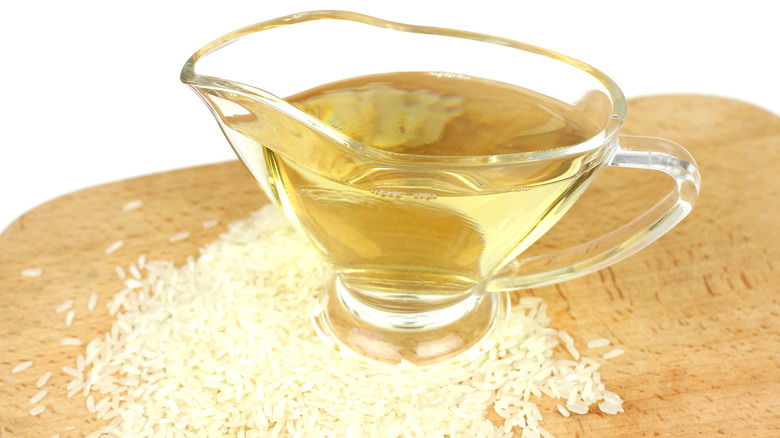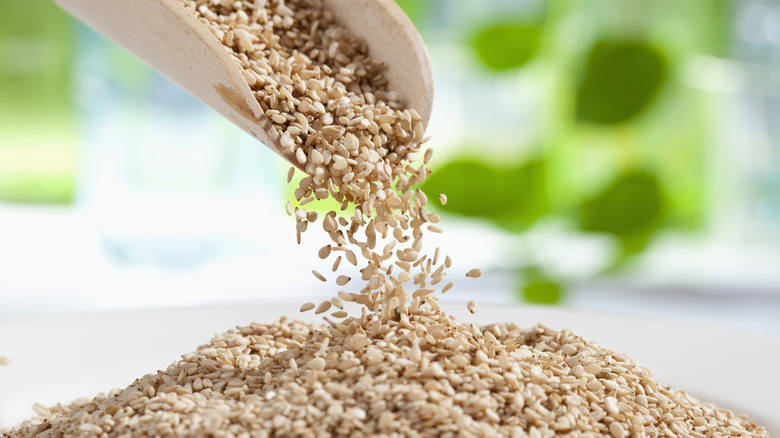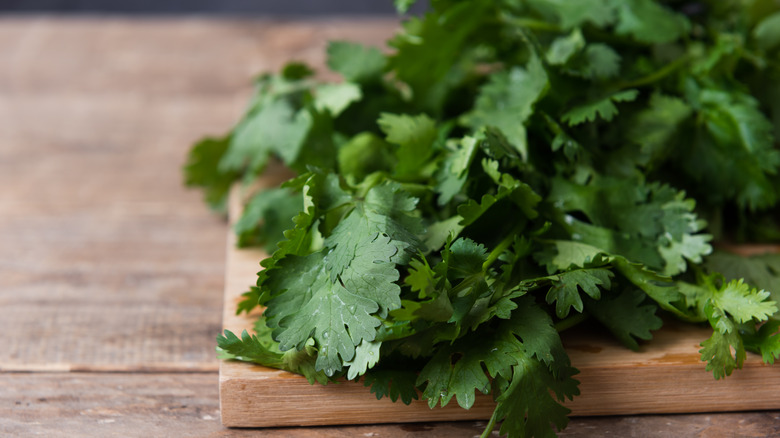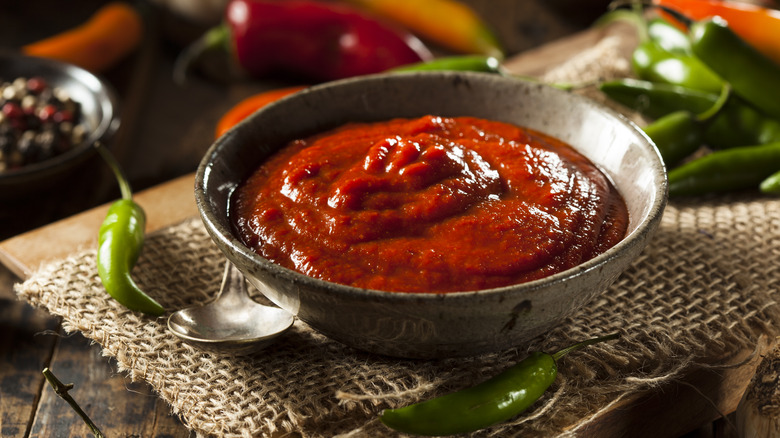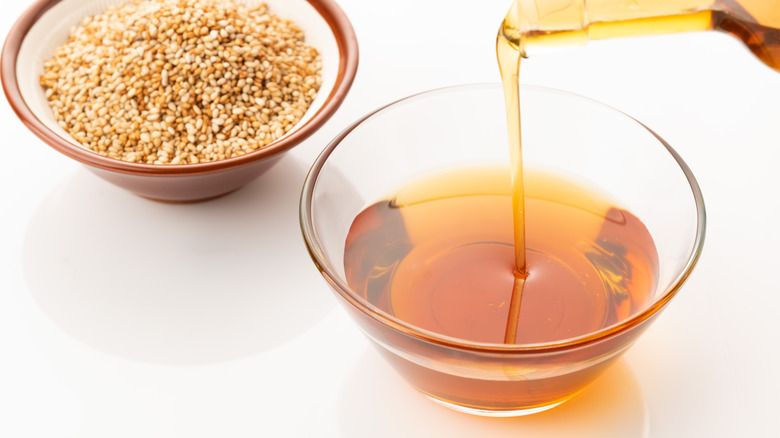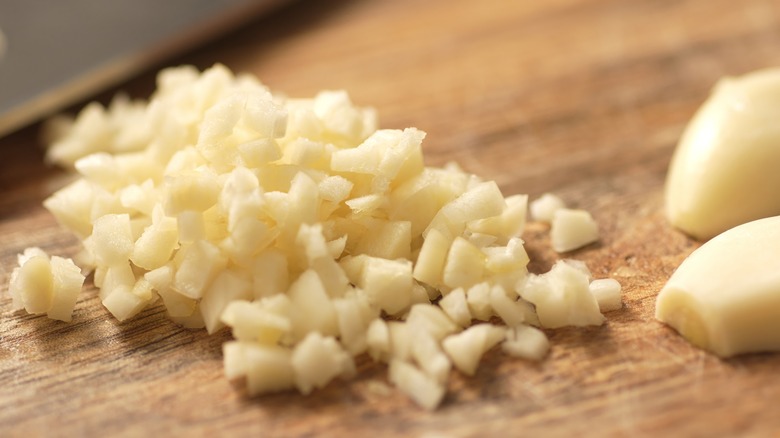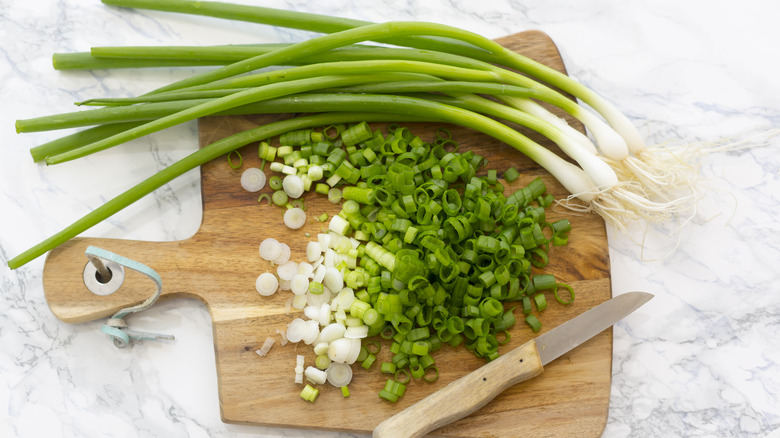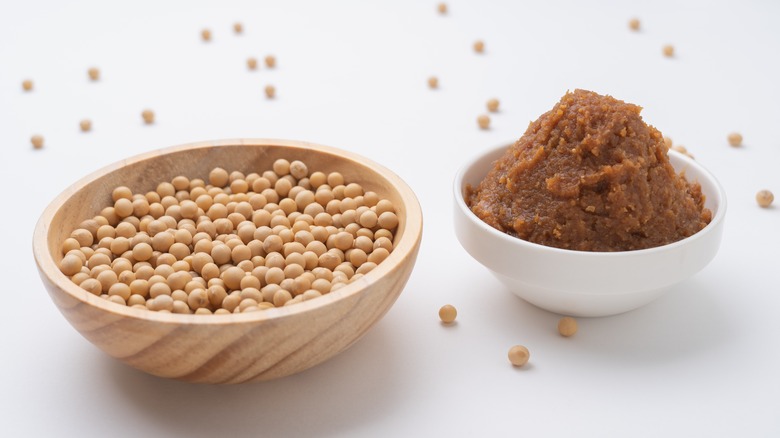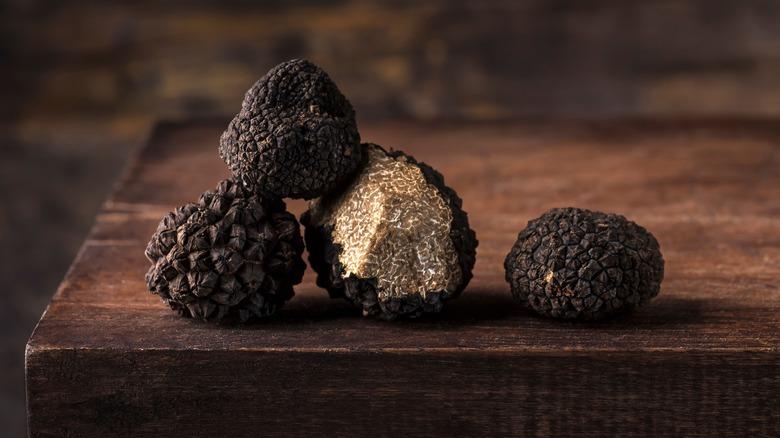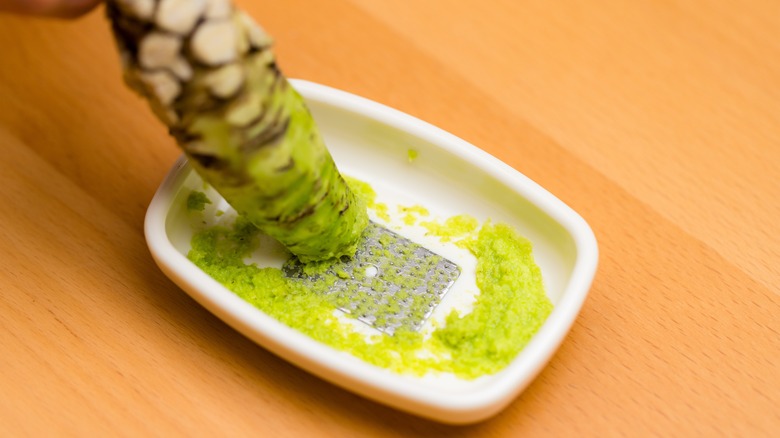15 Ingredients You Should Be Adding To Store-Bought Soy Sauce
Most home cooks have a bottle of soy sauce stocked and ready to use. Even if you have a favorite among the soy sauce brands, you might want to enhance its taste to tailor it to a specific meal or give it depth. We have a few ideas for ingredients you should be adding to store-bought soy sauce. These options allow you to use it as a dressing, dip, or seasoning for a variety of dishes. To help us compile the absolute best add-ins, we spoke with a few skilled chefs to give us insight.
Corrie Duffy is a chef and food blogger at Corrie Cooks who uses soy sauce in many dishes. Chef Ben Wenzel is the general manager at Virginia's River Stone Chophouse, which has steaks, seafood, and a raw bar. Nic Vanderbeeken is the executive chef at Apéritif Restaurant in Bali. "With over 20 years of professional cooking experience, I've found a few additions that really elevate this staple ingredient," says Vanderbeeken.
Store-bought soy sauce can be a great base for many meals, vegetables, and sides, and these diverse ingredients can give it a powerful boost of heat, sweetness, or other notes — many of which can be used in tandem for additional intensity. Keep reading to discover a few fresh methods to tweak store-bought soy sauce to make it a versatile and delicious way to transform anything it touches.
Ginger
Ginger makes a sweet but spicy choice when you want to balance the saltiness of soy sauce. "It also adds a bit of warmth, making it a perfect companion for both hot and cold dishes," says Ben Wenzel. For best results, fresh ginger delivers more flavor and a tender texture than ginger you've kept in the pantry for too long or powdered ginger. "Older ginger can be tough and woody, which doesn't incorporate as well into the sauce," Wenzel says.
Because it brings so much taste to the table, ginger root can be used in many dishes. Try the sweet, spicy, and salty sauce to marinate fish such as salmon or tuna or flavor stir-fried veggies or noodles. "I typically use this mix as a marinade for meats or a dipping sauce for dumplings," says Nic Vanderbeeken. Grating is a popular technique that allows for a more well-incorporated sauce, whereas thinly slicing the root makes the texture more pronounced. Corrie Duffy recommends grating fresh ginger and steeping it in the soy sauce for 10 minutes. Use ginger to bring a warm and zesty kick to your soy sauce.
Lemongrass
While this addition looks a bit like a scallion, it has a distinct lemony and tangy taste with hints of mint and grass. You can taste its sharpness in your dish, but it doesn't overwhelm it or make it bitter the way a fresh lemon or its juice might. Its potency and flavor vary based on whether fresh or dry, with the dry version being more muted and woody. As far as how to cook with it, you'll need to remove the outer layers of the fresh lemongrass by cutting from both the top and bottom. You'll notice a softer interior, which you can finely chop or grate for the soy sauce.
Incorporate other flavor elements like garlic and chili, which you can combine in a mortar and pestle with the lemongrass to create a paste. Or, try it with ingredients such as lime juice and fish sauce. These are delicious marinades picks for meat like chicken or pork shoulder. Use it as a dipping sauce for spring rolls or just drizzle the lemongrass soy sauce over vegetables or tuna.
Rice vinegar
Although there are different types of vinegar, you don't want to use just anything kind. Rice vinegar is often found in Asian recipes and can add a zingy sharpness that slashes through the saltiness of the soy sauce. As Corrie Duffy puts it, the rice vinegar introduces a tangy brightness. The duo can be a delicious choice for many dishes. Mix equal parts vinegar and soy sauce, but you might choose to customize it based on preference.
"I find this combination particularly useful in salad dressings or as a finishing touch on grilled vegetables," says Nic Vanderbeeken. The vinegar lightens the soy sauce to round out the flavor in a balance of salty and acidic. It pairs with fresh, vibrant dishes to match the tang of the vinegar. You could also turn it into a dipping sauce by integrating other flavors like sesame oil and jalapeño, or ginger and garlic. Mix your rice vinegar and soy sauce concoction into fried rice, pour it over scallion pancakes, or use it to liven up fried tofu.
Sesame seeds
There are plenty of creative ways to use sesame seeds and soy sauce to create a savory condiment. Combine soy sauce, vinegar, honey, and sesame seeds to make a nutty, salty salad dressing. The seeds offer texture, a light crunch, and mild nuttiness. It's the perfect salad dressing when you're bored of ranch or oil and vinegar. Briefly roast the seeds as an added step to bring out more flavor and its natural oils. This process doesn't take long since the seeds are so tiny, but you can burn them if you toast them too long.
If you don't want the crunch of the seeds, you could grind them into a powder in a mortar and pestle or a food processor. Then, mix it with the other ingredients. Instead of a salad dressing, create a dipping sauce to season veggies, rice, or meats by combining sesame seeds, soy sauce, red chili pepper flakes, tahini, or honey. These ingredients allow you to sway it spicy or sweet based on your mood and what you want to dip into it.
Cilantro
Breathe herby freshness and lightness into your sauce with vibrant green cilantro. The herbaceous addition balances the salty sauce with its citrus, lemon, and pepper notes (although cilantro tastes like soap to some people) and offers a visual component. Ben Wenzel recommends finely chopping fresh cilantro leaves and mixing them into the soy sauce. Large pieces are more challenging to eat. Let the blend sit for a few minutes to infuse the flavors slightly. This isn't something to prepare the day ahead because adding it too early can cause the green herb to become wilted and lose its taste.
However, Wenzel says you can skip the steeping step altogether to maintain the freshness of the cilantro and save yourself some prep time. Add the chopped herb just before serving to retain its flavor and deep color. This herbal mix is ideal for marinating chicken or seafood, especially if you plan to grill it. "It's also a great addition to fried rice or as a finishing touch for soups," says Wenzel. For added flavor, incorporate garlic, sesame oil, and chives into the delicious sauce.
Sriracha
This bright red spicy condiment is a perfect choice for soy sauce. Sriracha is a unique blend of heat from the chiles, vinegar, and sugar, so it's not a one-note addition. It adds volume and changes the flavor and color of your sauce to make it interesting and bold. Add the spicy sauce little by little until you reach your desired taste. Even if you're a spice enthusiast, it can quickly overtake other flavors in your dish.
Mixing the umami soy sauce, sriracha, peanut butter, and a few other ingredients is just one of many creative ways to use sriracha. Use the thick, spicy peanut sauce to season vegetables like roasted cauliflower, air-fried tofu skewers, noodles, and more. Create a sweeter sauce using honey or brown sugar, sriracha, soy sauce, sesame oil, and fresh lime juice. Whether you construct a sauce with multiple ingredients or keep it simple with sriracha and soy sauce, these can efficiently jazz up bland food in a complex way.
Sesame oil
Made from pressed sesame seeds, sesame oil offers unique qualities compared to the whole seed. It deepens the flavor of food thanks to its smooth, rich, and oily qualities. If you were to grind sesame seeds into a powder, it would still have a gritty element, so the oil version brings something special into the mix. "A small amount of toasted sesame oil can completely transform soy sauce by adding a rich, nutty aroma and a velvety texture," says Nic Vanderbeeken. Use either toasted or un-toasted sesame oil; the former has a deeper, more pronounced flavor if you want a nuttier impact.
You don't need much oil to give a nutty taste since too much can turn the soy sauce condiment oily. "Just a few drops are enough to give the soy sauce a deeper, more rounded flavor, making it a versatile seasoning for various dishes," Vanderbeeken advises. Thoroughly mix it to ensure minimal separation and drizzle over steamed rice, stir-fried noodles, or vegetables. For a bit of sweetness, combine with rice wine vinegar and honey to produce a delicious dipping sauce for foods like egg rolls and potstickers.
Pineapple juice
Sweet and salty create a delightful combination, so the vibrant notes of pineapple juice work with the sodium in soy sauce. The juice offers a sugary, tangy taste but adds a liquid component and loose consistency, making it ideal for a marinade or dipping sauce. This is easily achieved with a can of plain pineapple juice or canned pineapple in pineapple juice. You can use canned pineapple and mix the fruit into your dish, like pineapple with chicken, pork, or fried rice.
Mix together pineapple juice, soy sauce, sesame oil, grated garlic, grated ginger, and a neutral oil like canola oil or peanut oil to construct a marinade for chicken, shrimp, or other proteins. Fresh pineapple makes a good meat tenderizer because of its bromelain enzyme, which dissolves collagen fibers to transform your meat so it's nice and supple. In this case, you can blend the fresh fruit in a blender or juicer to produce the juice from scratch and pair it with soy sauce. Place the marinade and meat in a closed container and let it sit in the fridge for at least three hours. Alternatively, you can assemble it into a dipping sauce for chicken nuggets or even sweet potato fries.
Garlic
Whether you add it raw or give it a quick sauté, garlic is an excellent addition to store-bought soy sauce. Corrie Duffy prefers minced and sautéed since it mellows soy sauce with a sweet, savory flavor. Don't burn the garlic, as this can cause it to taste bitter. On the other hand, Ben Wenzel says you can mince the fresh garlic, stir it into the soy sauce, let it sit for a few minutes, and then it's ready to use.
"This combination works beautifully as a marinade for meats — especially chicken, beef, or pork," says Wenzel. Allot 30 minutes for the soy sauce and chopped garlic to sit with the meat as a marinade. This allows the garlic to infuse flavor into the meat and makes a more fragrant sauce. But the garlic and soy sauce duo is a superb condiment to dip dumplings or spring rolls into. Don't stop at garlic alone. Bring more depth by seasoning your soy sauce with shallots and green onions. You'll find that garlic and soy sauce work with a range of flavors if you want to include more ingredients in your condiment.
Scallions
Scallions are a top nominee for ingredients you should be adding to store-bought soy sauce. But you can also incorporate other elements to further enhance the flavor and fragrance. Chop scallions to integrate into scallion pancakes, and then make a sauce with soy sauce, vinegar, scallions, and a couple of other ingredients. You can dip the pancakes into this tasty sauce or pour it all over the pancake itself.
Create a spicier flavoring with scallions, soy sauce, red chili paste, and the sweet heat of ginger. The scallions impart their sharp, peppery, and oniony flavor but also provide texture and a beautiful color that makes them a striking choice for the brown soy sauce. They are an appealing, aromatic choice for many kinds of dishes like steamed eggplant, baked tofu, or wontons. There are plenty of deliciously creative ways to use scallions, and pairing them with soy sauce is one of many.
Miso paste
Soy sauce and miso have a tantalizing umami flavor. Together, they are a delicious duo. Due to its thickness, the miso creates an almost creamy appearance in the sauce. Combine it with other flavors like maple syrup, lemongrass, ginger, lime, or sesame oil to make a sauce that you can use for many meals and sides. You can also use your intuition as far as how much of each ingredient to add.
Add more if you like the spicy, warming, sweet kick of ginger. If you want to thin out the sauce and give it more brightness, squeeze more lime juice. Miso and soy sauce can be quite salty, so keep this in mind when seasoning your food or if you have to monitor your sodium. To combat this, opt for low-sodium soy sauce or be mindful of how much you pour or dip into your food to avoid an overly salty flavor.
Honey
Honey is another sugary ingredient to include in soy sauce because it introduces a natural sweetness that establishes a delightful consonance. This is a particularly compelling ingredient for glazes that you can spread onto roasted meats or use as a dipping sauce for tempura, according to Nic Vanderbeeken. If you have honey in your cupboard, you might notice it's sticky, thick, and hard to work with. "I suggest warming the honey slightly before mixing it with the soy sauce to ensure it blends smoothly and evenly," says Vanderbeeken. This exact procedure applies when your honey crystallizes. It's still perfectly edible and a normal part of the honey's aging process.
You might also notice that different types of honey produce unique flavors, like the floral notes of wildflower honey or the mildness of clover honey. This can bring a nuanced taste to your flavoring, and you don't have to stop at honey for your soy sauce. You may include other ingredients like red chili pepper flakes, garlic, ginger, or sesame oil. This is a scrumptious sauce to pour onto salmon, shrimp, or your favorite vegetables to give it a salty and sweet kick.
Chili
Adding a bit of spice to the mix might be exactly what your soy sauce needs and there are plenty of options. Ben Wenzel recommends fresh red chili, which brings spicy heat, vibrant color, and a hint of crunchiness to the sauce. Slice fresh red chili into thin rounds and incorporate them into the soy sauce. This allows flexibility because you can adjust the heat level by modifying the amount of chili you include. "You can always add more, but you can't take it out once it's in there," says Wenzel. This is a marvelous choice for marinating beef or pork, but you can also use it as a spicy dipping sauce for grilled tofu or vegetables.
Corrie Duffy and Nic Vanderbeeken both recommend dried chili flakes. Duffy says it enhances the complexity of the soy sauce. These dried chili pieces are widely available and affordable for your spice drawer. You don't have to worry about them molding like you would for the fresh version. "It's a quick way to introduce heat and a bit of texture," says Vanderbeeken. This combination works as a dipping sauce for sushi, poured onto noodles, or drizzling over sautéed greens. Start with a pinch, taste the sauce, and add more as desired, as you would when using fresh chiles.
Truffle
This luxurious condiment can quickly heighten your meal. Because black truffles are expensive, you might want to make them for a special occasion or celebration. But, hey, you can commemorate any old Monday with truffle soy sauce if you really want to. Although a few of these types of sauce are available on the market, you can create your own. Some store versions have undisclosed truffle flavoring, so making it at home with truffle goes a step beyond. Use store-bought soy sauce and your truffle of choice, such as summer, black, or truffle oil, to infuse your own. The oil is the easiest method since you can quickly mix the oil and soy sauce and serve immediately.
Truffle isn't for everyone. Some might be put off by its earthy and musky scent, which gives soy sauce a noticeable aromatic quality. Use the fancy sauce for udon, ramen, or dumplings. But you could use it for pasta or risotto dishes by mixing it with a creamy sauce. This might be one of the more pricey but special ingredients you should be adding to store-bought soy sauce.
Wasabi
Wasabi's green hue makes it a recognizable food. It's similar to horseradish or hot mustard with an aromatic spicy flavor that hits the nose. Wasabi is often used as an accompaniment to sushi, making it a fantastic pairing for soy sauce. Ben Wenzel recommends a tasty cross of wasabi, pickled ginger, and soy sauce for sushi dips. If you plan ahead, complete pickled ginger from scratch the night before for an unforgettable palate-cleanser.
Wenzel shares that the sharpness of the wasabi works perfectly with the saltiness of the soy sauce, while pickled ginger brings a sweet and tangy contrast. For this flavor pairing, you don't need to physically mix everything in a bowl. Integrate a small amount of wasabi into the soy sauce until it fully dissolves. Then, serve the pickled ginger on the side, which you can dip into the sauce. It produces a harmonious blend that enhances sushi, sashimi, or other raw seafood dishes. "Be cautious with the wasabi — start with a small amount and add more to taste, as it can quickly overpower the soy sauce," Wenzel says. This way, you can control the balance of flavors and adjust to your preference.
